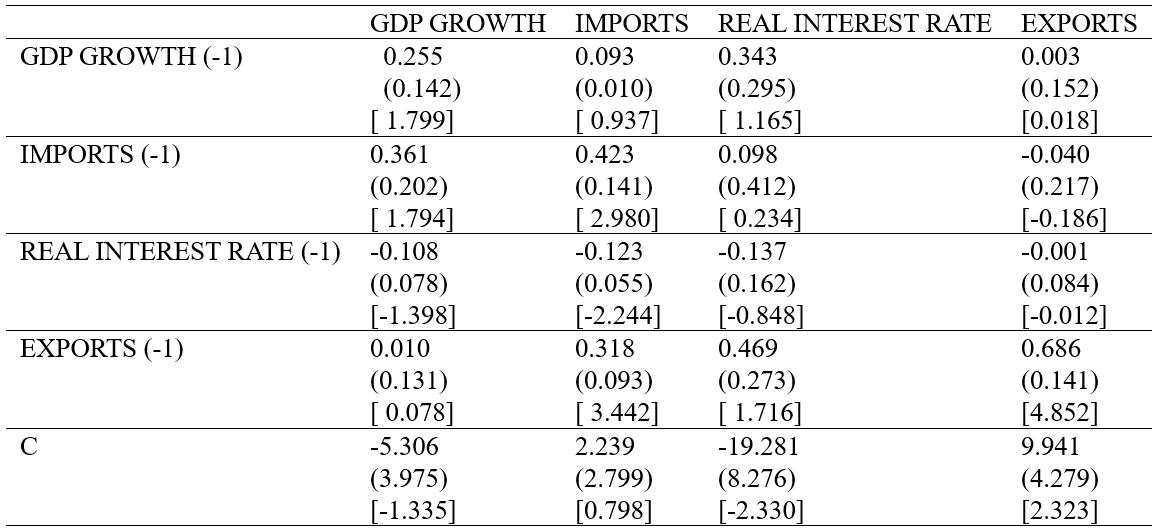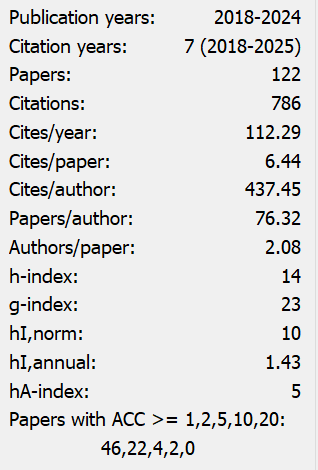Econometric Analysis of Export Led Growth in the Nigerian Economy
Abstract
This study investigates the role of export in the economic growth process of Nigeria with using the three sample periods of annual time series data, which are 1961 to 2013, 1970 to 2013 and 1981 to 2013 respectively. The variables for this period of 1961 to 2013 are GDP growth and exports/GDP ratio, the variables for this period of 1970 to 2013 are GDP growth, exports/GDP ratio, Imports/GDP ratio and the real interest rate and the variables for the last period of data are total exports, manufacturing GDP, agricultural GDP, manufacturing exports and agricultural exports respectively. The VAR Granger causality results for the first sample period show no causal relationship between exports and the GDP growth which illustrates that the two variables are independent of each other. The VAR results for the period of 1970 to 2013 show no causality between the variables under consideration. Following the results of the Granger causality test for this last period of 1981 to 2013, the results show no evidence of causality existing among the variables, which do not show evidence for the support for the export-led growth in the Nigerian economy. This study concluded that exports do not influence and cannot sustain economic growth in the Nigerian economy. The study recommended that an attempt should be made towards executing an economic policy that will strengthen the economic growth of Nigeria.
References
Alimi, S. R., & Muse, B. O. (2012). Export-led growth or growth - driven exports? Evidence from Nigeria. British Journal of Economics, Management & Trade, 3(2), 89-100. https://doi.org/10.9734/BJEMT/2013/2386
Budina, N., & Pang, G. (2007). Nigeria’s Growth Record: Dutch Disease or Debt Overhang? World Bank Policy Research Working Paper 4256 (June 2007) 1-32.
Central Bank of Nigeria. (1993). Available at http://www.cenbank.org/MonetaryPolicy/policy.asp (Accessed: 13 September 2013).
Central Intelligence Agency. (2014). Nigeria. In The World Facebook. Available from Retrieved June 10th, 2015 from https://www.cia.gov/library/publications/the-world-factbook/geos/ni.html
Comparative advantage. Business Dictionary.com (no date). Retrieved August 30th, 2015 from http://www.businessdictionary.com/definition/comparative-advantage.html
Dreger, C., & Herzer, D. (2011). A further examination of the export-led growth hypothesis, Discussion paper//European University Viadrina, Department of Business Administration and Economics, No. 305. ISSN 1860 0921. pp. 1-40.
Dritsakis, N. (2005). Exports and economic growth: an annual empirical investigation of EU, USA and Japan using causality tests, Department of Applied Informatics, University of Macedonia, Economics and Social Sciences. Cited in Achchuthan, S. Journal of Economics and Sustainable Development, 4(9), 148-150. ISSN 2222-1700 (paper) ISSN 222-2885 (Online).
Dumping. Business Dictionary.com (no date). Retrieved September 13th, 2015 from http://www.businessdictionary.com/definition/comparative-advantage.html
Ekpo & Umoh. Retrieved September 13th, 2015 from http:/www.onlinenigeria.com/economics
Herrerias, M. J., & Vincente, O. (2010). Is the Export-Led Growth Hypothesis Enough to Account for China’s Growth? China & World Economy, 18(4), 34-51. https://doi.org/10.1111/j.1749-124X.2010.01203.x
Ibrahim, Ayodele A., Hakeem M. and Yinka, Adeniran A. (2014). Oil price shocks and Nigerian Economic growth. European Scientific Journal, 10(19). ISSN: 1857-7881.
James, S. H., & Mark, W. W. (2012): Introduction to Econometrics. 3rdeds. Pearson Education Limited. ISBN 978-0-13-800900-7. pp 276-677.
Mahadevan, R. (2007). New Evidence on the Export-led Growth Nexus: A Case Study of Malaysia. The World Economy, 1069-1083. https://doi.org/10.1111/j.1467-9701.2007.01030.x
Makua, C. G. O., Kelechi, C. O., & Joseph, O. C. (2014). Export-led Growth Hypothesis in Nigeria: Applications of ARDL Model and Co-integration Analysis. Global Journal of Emerging Market Economies, 6(1), 5-13. https://doi.org/10.1177/0974910113511190
Maximilian, B. (2011). How export-led growth can lead to take-off. Working Paper, 222, 1-17. ISSN 1860-5508.
Musley, D. (2004). Exports, Imports, and Economic Growth in South Asia: Evidence Using a Multivariate Time-series Framework. The Pakistan Development Review, 43(2), 109-114. https://doi.org/10.30541/v43i2pp.105-124
Okuneye, P. A., Fabusoro, E. K., Adebayo, & Ayinde, I. A. (2004). The Nigerian agriculture and poverty incidence: The need for private sector empowerment. Paper prepared for presentation at the Farm Management Association of Nigeria Conference, Abuja, Nigeria Oct. 19-21, 54-65.
Okuntola, B. (2012). The Babangida Years and Private Sector Initiatives in the Restructuring of the Nigerian Economy, 1985-1993. African Nebula, 5, 32-41.
Olaniyi, E. (2013). Testing Finance-Led, Export-Led and Import-Led Growth Hypotheses on Four Sub-Saharan African Economies. MPRA Paper, No. 52460, 1-53. Retrieved from http://mpra.ub.uni-muenchen.de/52460/
Palley, T. I. (2000). Export-Led Growth: Evidence of Developing Country Crowding-Out. Published in Economic Integration, Regionalism, and Globalization, Arestis, Baddeley & Mc Combie (eds.), Cheltenham: Edward Elgar, 2003. Pp. 1-28.
Tuck, T. C., & Ravin, C. (2013). Export-Led Growth in Cambodia: An Empirical Study. Economics Bulletin, 33(1), 1-10.
UK Essays. (November 2013). Import Substitution Policy versus Export-Led Growth Strategy Economics Essay. Retrieved August 30th, 2015 from http://www.ukessays.com/essays/economics/import-substitution-policy-versus-export-led-growth-strategy-economics-essay.php?cref=1


This work is licensed under a Creative Commons Attribution 4.0 International License.
Copyright for this article is retained by the author(s), with first publication rights granted to the journal.
This is an open-access article distributed under the terms and conditions of the Creative Commons Attribution license (http://creativecommons.org/licenses/by/4.0/).


























